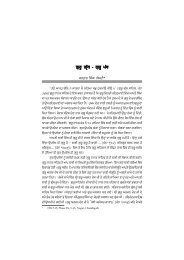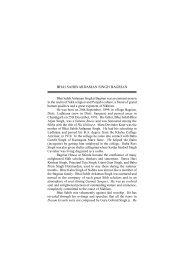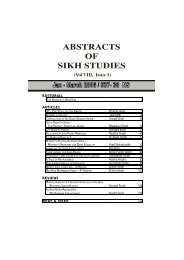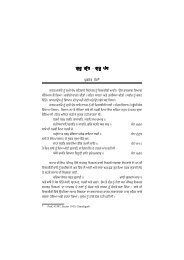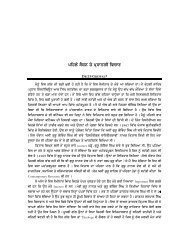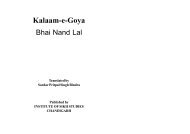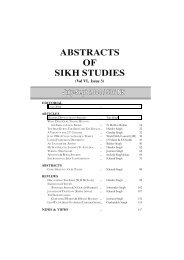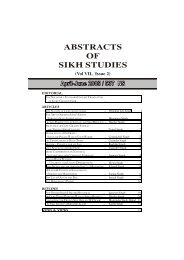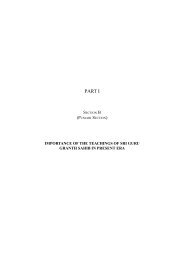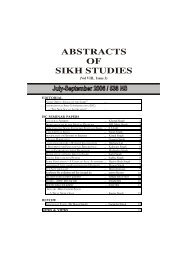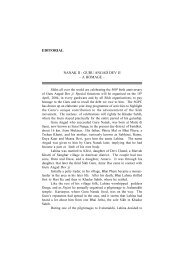Sri Guru Granth Sahib - Institute of Sikh Studies
Sri Guru Granth Sahib - Institute of Sikh Studies
Sri Guru Granth Sahib - Institute of Sikh Studies
You also want an ePaper? Increase the reach of your titles
YUMPU automatically turns print PDFs into web optimized ePapers that Google loves.
SRI GURU GRANTH SAHIB: ITS STRUCTURE33SRI GURU GRANTH SAHIB: ITS STRUCTURESIMREN KAUR*INTRODUCTION<strong>Sri</strong> <strong>Guru</strong> <strong>Granth</strong> <strong>Sahib</strong>, the <strong>Sikh</strong> Scripture, has the uniquedistinction <strong>of</strong> having been compiled by the <strong>Sikh</strong> preceptors themselvesand, thus, the structure can be described as nothing else butmethodically flawless. The purpose for the accumulation <strong>of</strong> canon by<strong>Guru</strong> Arjun Dev Ji, and later <strong>Guru</strong> Gobind Singh Ji, was because “asthe Panth has been revealed unto the world, so must there be the <strong>Granth</strong>,too”. Some historians allege that the systematisation <strong>of</strong> Bani wasprepared with the aim to protect their sanctity from destructive aims.The steps which were taken by <strong>Guru</strong> Arjun Dev Ji to purify Baniare as follows:– Ragas which expressed excessive exuberance or sadness wererejected.– The <strong>Guru</strong> did not make any distinction between ragas and raginisaccording to the popular Indian catalogue style because thesuperfluous raginis were also used as ragas.– Poetry <strong>of</strong> saints containing negative thoughts (eg: ego,discrimination, degradation <strong>of</strong> human life and renunciation, etc)were excluded.– Direct language, as the accepted vehicle <strong>of</strong> literary expression atthat time, expressed the Bani in simple metaphors.– The numerical codification <strong>of</strong> the collections is such that nointerpolation can be made.– Bhagat Bani is clarified in many areas by the <strong>Guru</strong>s as clearlynoted in SGGS.* Student <strong>of</strong> MBBS IV, The University <strong>of</strong> New South Wales, Australia, Email:
34ABSTRACTS OF SIKH STUDIES: JULY-SEPT 2012 / 544 NSTHE AUTHORSAn interesting point in the structure <strong>of</strong> the SGGS can be madeabout the included lyricists. With no distinction <strong>of</strong> label, SGGS is notonly an anthology <strong>of</strong> the sacred compositions <strong>of</strong> the <strong>Guru</strong>s (<strong>Guru</strong>Nanak Dev Ji, <strong>Guru</strong> Angad Dev Ji, <strong>Guru</strong> Amar Das Ji, <strong>Guru</strong> Ram DasJi, <strong>Guru</strong> Arjun Dev Ji and <strong>Guru</strong> Teg Bahadur Ji), but also <strong>of</strong> somemedieval Indian Bhagats and Bhatts, furthering its uniqueness withthe inclusion <strong>of</strong> compositions from poets other than the faith <strong>of</strong> thefollowers. The composers came from a variety <strong>of</strong> class and creedalbackground, from Muslims to Hindus and from upper caste to low caste.The full list <strong>of</strong> non-<strong>Guru</strong> authors is broad, including BhagatsKabir, Farid and Namdev, Ravidas, Beni, Trilochan, Jaidev, Surdas,Parmanand, Sadhana, Ramanand, Dhanna, Pipa, Sain, Bhikhan, Sundarand Mardana; poets Balwand and Sata; and many Bhatts (poets), suchas Bhatt Balh, Bhatt Bhalh, Bhatt Bhika, Bhatt Gayand, Bhatt Harbans,Bhatt Jalap, Bhatt Kalshar, Bhatt Kirat, Bhatt Mathura, Bhatt Nalhand Bhatt Salh.The lack <strong>of</strong> discrimination in SGGS is due to the progressivethoughts <strong>of</strong> <strong>Sikh</strong>ism. Also, the origin <strong>of</strong> <strong>Sikh</strong>ism took place in a periodwhen India passed through a process <strong>of</strong> cultural transition. Theconcepts, signs and symbols <strong>of</strong> spiritual and material communicationused in SGGS are evidence <strong>of</strong> the historical process <strong>of</strong> cultural fusion,social and political change which took place in that society. There is aconsiderable vocabulary reserved in <strong>Guru</strong> <strong>Granth</strong> <strong>Sahib</strong> from areas <strong>of</strong>religion, philosophy, mysticism, mythology, law and more commonconcerns <strong>of</strong> life from Persian, Arabic, Sanskrit, Punjabi and Brajlanguages.THE SECTIONSThe structure <strong>of</strong> the voluminous scripture that is SGGS can bedivided into three sections: pre-raga section, raga section and postragasection.THE PRE-RAGA SECTIONIn the pre-raga section (pages 1 to 13), the pride <strong>of</strong> place is givento Japji (pages 1 to 8), a composition <strong>of</strong> <strong>Guru</strong> Nanak Dev Ji. Japji, amorning prayer, is one <strong>of</strong> the most famous spiritual compositions <strong>of</strong><strong>Sikh</strong> scripture. Commencing with philosophically dense ideas, MoolMantar (page 1) is considered the basis <strong>of</strong> <strong>Sikh</strong> theology. Japji comprises
SRI GURU GRANTH SAHIB: ITS STRUCTURE3538 Pauris or stanzas, and then the Salok which is the final verse.After the Japji, the hymn <strong>of</strong> evening prayer called Rahiras (pages8 to 12) is scripted in two parts (So Dar, which comprises <strong>of</strong> 5 Shabads,and So Purakh, which comprises <strong>of</strong> 4 Shabads) and then the KirtanSohila (pages 12 to 13, which comprises <strong>of</strong> 5 Shabads), a group <strong>of</strong>hymns to be recited before retiring at night.THE RAGA SECTIONThe second section <strong>of</strong> SGGS is the raga section (pages 14 to1353), ordered primarily on the basis <strong>of</strong> each composition’s raga. Thus,the structural formation <strong>of</strong> the content matter <strong>of</strong> <strong>Guru</strong> <strong>Granth</strong> <strong>Sahib</strong>has wonderful aesthetic value. The following table is a list <strong>of</strong> all theragas used in <strong>Guru</strong> <strong>Granth</strong> <strong>Sahib</strong>.Raga Page No Raga Page No<strong>Sri</strong> Raga 14 to 93 Raga Gaund 859 to 875Raga Majh 94 to 150 Raga Ramkali 876 to 974Raga Gauri 151 to 346 Raga Nat Narayan 975 to 983Raga Asa 347 to 488 Raga Mali Gaura 984 to 988Raga Gujari 489 to 526 Raga Maru 889 to 1106Raga Devgandhari 527 to 536 Raga Tukhari 1107 to 1117Raga Bihagara 537 to 556 Raga Kedara 1118 to 1124Raga Wadhans 557 to 594 Raga Bhairon 1125 to 1167Raga Sorath 595 to 659 Raga Basant 1168 to 1196Raga Dhanasari 660 to 695 Raga Sarang 1197 to 1253Raga Jaitsari 696 to 710 Raga Malar 1254 to 1293Raga Todi 711 to 718 Raga Kanara 1294 to 1318Raga Bairari 719 to 720 Raga Kalyan 1319 to 1326Raga Tilang 721 to 727 Raga Parbhatti 1327 to 1351Raga Suhi 728 to 794 Raga Jaijaiwanti 1352 to 1353Raga Bilaval 795 to 858The structure <strong>of</strong> SGGS can be appreciated by grouping Sabads<strong>of</strong> the same theme together by raga, since each raga invokes certainfeelings. The following table briefly explains the feelings invoked byeach <strong>of</strong> the ragas.RagaSoohiBilaavalCommon ThemeBeing away from home. The soul being away from theHouse <strong>of</strong> Lord and the joy <strong>of</strong> meeting the true“husband” (ie. Akal Purakh)Beautification <strong>of</strong> soul, happiness
36ABSTRACTS OF SIKH STUDIES: JULY-SEPT 2012 / 544 NSGaund Separation, union, surprise<strong>Sri</strong> Maya and detachmentMaajh yearning to merge with Lord, giving up <strong>of</strong> negativevaluesGauri Principles, serious, thoughtfulness, composedAasa HopeGujri Prayer (Pooja)DevgandhariMerging with spouse, self - realizationBihaagra Yearning due to separation <strong>of</strong> soul and happiness dueto meeting the LordSorath Merits <strong>of</strong> GodDhanasari Mixed themeJaitsree StabilityTodi Maya, separationBairagi motivation to sing praises <strong>of</strong> LordTilang Sadness, beautificationRaamkali To give up the life <strong>of</strong> a wandering JogiNat NarayanJoy <strong>of</strong> meeting the LordMaali Gaura HappinessMaaru Bravery, pr<strong>of</strong>ound philosophyTukhari Separation and union with LordKedara LoveBhairav Man’s state <strong>of</strong> hellBasant HappinessSarang Thirst to meet GodMalaar State <strong>of</strong> separated and united soulJaijawanti Vairaag (Detachment)Kalyaan Bhakti (Prayer) RasVadhans Vairaag (Detachment)Parbhatti Bhakti (Prayer)Kaanra Bhakti (Prayer)The use <strong>of</strong> ragas as invoking certain feelings increases the deliverypower <strong>of</strong> Sabad, as the raga complements the message <strong>of</strong> the Kirtan.“Among all ragas, that one is sublime, O Siblings <strong>of</strong> Destiny, by whichGod comes to abide in the mind.” Thus, only the Sabad’s prescribedraga creates the correct atmosphere for which the Kirtan must be sung.Another interesting aspect <strong>of</strong> ragas and Gurbani classification isunderstood by studying daily time-cycles. A raga has a preferred timing
SRI GURU GRANTH SAHIB: ITS STRUCTURE37associated with it. The timings <strong>of</strong> ragas also complement the changesin human moods and heart during a twenty-four hour time cycle.Time Period Raga6 AM - 9 AM: Bhairaagi, Devgandhari9 AM - 12 PM: Saarang, Suhi, Bilaaval, Gujri, Gond, Todi12 PM - 3 PM: Vadhans, Maru, Dhanasari3 PM - 6 PM: Maanjh, Gauri, Tilang, Tukhari6 PM - 9 PM: <strong>Sri</strong>, Basant, Maali Gaura, Jaitsree, Kedara, Kalyaan9 PM - 12 AM: Bihaagra, Nat Narayan, Sorath, Malaar, Kaanra,Jaijawanti12 AM - 3 AM: No Raags from <strong>Guru</strong> <strong>Granth</strong> <strong>Sahib</strong>3 AM - 6 AM: Aasa, Raamkali, Bhairav, ParbhattiSome ragas are also advised to be sung in certain seasons. Forexample, Basant raga can be sung at any time in Basant (spring) season.Shabads with the theme <strong>of</strong> happiness are clustered under this raga in<strong>Guru</strong> <strong>Granth</strong> <strong>Sahib</strong>. Also, Malaar raga can be sung at any time in therainy season. Shabads with the theme <strong>of</strong> separation are clustered underthis raga in <strong>Guru</strong> <strong>Granth</strong> <strong>Sahib</strong>.After their ragas, the compilations in SGGS are arranged on theirmetre: Sabads, such as Chaupadas (quatrains) and Ashtpadis (octets),followed by Chhants (six line lyrics), then Vars (long narrativecompositions) and, finally, poems <strong>of</strong> Bhagats.Within each metre, the compositions are further ordered uponthe basis <strong>of</strong> the author. After the <strong>Guru</strong>s’ compositions (the <strong>Guru</strong>s’compositions are arranged in order <strong>of</strong> their succession <strong>of</strong> <strong>Guru</strong>shipand with the term Mahalla or Master), the compositions <strong>of</strong> the Bhagatsare ordered with Kabir being given the principle place. The names <strong>of</strong>the Bhagats and saints are given with their compositions.The final ordering is based upon the Ghars <strong>of</strong> the Shabads. Thereare 17 Ghars (Taals or beats), from Ghar 1 (Dadra) to Ghar 17 (Chrchari).The following table is a list <strong>of</strong> the Ghars in <strong>Guru</strong> <strong>Granth</strong> <strong>Sahib</strong>.Ghar Name Ghar No Taalis and MaatraasDadra Taal Ghar 1 There are 1 Taalis and the Beat has 6 MaatraasRupak Taal Ghar 2 There are 2 Taalis and the Beat has 7 MaatraasTeen Taal Ghar 3 There are 3 Taalis and the Beat has 16 MaatraasChaar Taal Ghar 4 There are 4 Taalis and the Beat has 12 MaatraasPunj Taal Ghar 5 There are 5 Taalis and the Beat has 15 MaatraasKhut Taal Ghar 6 There are 6 Taalis and the Beat has 18 Maatraas
38ABSTRACTS OF SIKH STUDIES: JULY-SEPT 2012 / 544 NSMut Taal Ghar 7 There are 7 Taalis and the Beat has 21 MaatraasAsht Mangal Taal Ghar 8 There are 8 Taalis and the Beat has 22 MaatraasMohini Taal Ghar 9 There are 9 Taalis and the Beat has 23 MaatraasBraham Taal Ghar 10 There are 10 Taalis and the Beat has 28 MaatraasRudra Taal Ghar 11 There are 11 Taalis and the Beat has 32 MaatraasVishnu Taal Ghar 12 There are 12 Taalis and the Beat has 36 MaatraasMuchkund Taal Ghar 13 There are 13 Taalis and the Beat has 34 MaatraasMahashani Taal Ghar 14 There are 14 Taalis and the Beat has 42 MaatraasMishr Baran Taal Ghar 15 There are 15 Taalis and the Beat has 47 MaatraasKul Taal Ghar 16 There are 16 Taalis and the Beat has 42 MaatraasChrchari Taal Ghar 17 There are 17 Taalis and the Beat has 40 MaatraasTHE POST-RAGA SECTIONThe post-raga section (pages 1353 to 1430) contains the Saloks,Swayyes and other compositions. At the close (page 1429) is theMundavani (seal) to mark the end <strong>of</strong> <strong>Guru</strong> <strong>Granth</strong> <strong>Sahib</strong>, so that nospurious compositions can thereafter be added, followed by a <strong>Guru</strong>Arjun Dev Ji’s thanks-giving Salok for the successful completion <strong>of</strong>the great task by Divine grace. At the end <strong>of</strong> the post-raga section isthe Ragamala (pages 1429 to 1430) which contains a catalogue <strong>of</strong>most <strong>of</strong> the ragas used in SGGS.THE RAHAU (PAUSE)Within the solid yet structured constitution <strong>of</strong> SGGS lays manyShabads, which contain the Rahau within them. The Rahau is a veryimportant part <strong>of</strong> the structure <strong>of</strong> each, individual Shabad becausethe meaning <strong>of</strong> the Rahau is the main theme <strong>of</strong> the Shabad or theGurmat Vichar (“the right thought”).A few important definitions in Kirtan are required beforeanalysing the implications <strong>of</strong> the Rahau.Aasthai (or Chorus) – one line that is repeated.Antra (or Verse) – lines that are changed after recitation <strong>of</strong> theAasthai.The purpose <strong>of</strong> Kirtan is to deliver the <strong>Guru</strong>s’ message sweetlyto the listener. As Rahau has the central theme <strong>of</strong> the Shabad andcontains the spiritual message it is used as an Aasthai. Without correctemphasis on the Rahau line and appropriate recognition <strong>of</strong> its meaning,the true message <strong>of</strong> the Shabad cannot be comprehended. The otherlines in the Shabad are used to extrapolate the contents <strong>of</strong> the central
SRI GURU GRANTH SAHIB: ITS STRUCTURE39theme given in the line <strong>of</strong> Rahau.The following example was taken from an essay submitted to theBritish Organisation <strong>of</strong> <strong>Sikh</strong> Students and illustrates the importance<strong>of</strong> the Rahau. The Shabad “Mere Man Eikas Sio Chit Laaye/ Eikas BinSabh Dhund Hai/ Sabh Mithiya Moh Maye” is sometimes sung with anAntra line “Lakh Khushian Patshahiyaan / Jey Satgur Nadar Karey” inplace <strong>of</strong> the Aasthai (or Rahau line).The Rahau line roughly translates to “All happiness is achievedonly by Thy Grace. The precious gift <strong>of</strong> this human life becomes fruitfulwhen one chants the True Word. One who has such destiny writtenon his forehead enters the Mansion <strong>of</strong> the Lord’s Presence throughthe <strong>Guru</strong>.”The other line translates to “Hundreds <strong>of</strong> thousands <strong>of</strong> princelypleasures are yours to enjoy if the True <strong>Guru</strong> bestows a Glance <strong>of</strong>Grace. If God bestows the Name <strong>of</strong> the Lord, even for a moment, mymind and body are soothed. Those who have such pre-ordained destinyhold tight to the Feet <strong>of</strong> the True <strong>Guru</strong>.”When the incorrect line is used as the Rahau, the meaning <strong>of</strong> theShabad becomes that we seek thousands <strong>of</strong> pleasures from our <strong>Guru</strong>,and only then will we strive towards freeing our minds <strong>of</strong> attachment/Maya.The intended message is that we need to give up attachment toMaya and emotional entanglements and, that if we succeed, thenthousands <strong>of</strong> pleasures will be attained only if God’s Grace falls upon us.This example accurately depicts the abrupt change indeliverability <strong>of</strong> the message to our mind from the incorrectinterpretation (we hope for blessings, and then make an effort to ridourselves <strong>of</strong> Maya) to the correct interpretation (we make an effortand then we hope for blessings).CONCLUSIONSGGS is a spiritual key communicated in the form <strong>of</strong> Bani,containing a message <strong>of</strong> love, faith, truth and justice. Bani is held ingreat veneration by the <strong>Sikh</strong>s as recognised by the line “Bani is theguru, and the guru is Bani.” Furthermore, SGGS is not simply a texttouting truth, but also embodies the ongoing spirit <strong>of</strong> the <strong>Guru</strong>ship,as recognised in Ardaas: “Agya Bhaee Akal Ki Tabhay Chalaiyo Panth /Sab <strong>Sikh</strong>an Ko Hukam Hai <strong>Guru</strong> Manyo <strong>Granth</strong>.” In fact, it has been
40ABSTRACTS OF SIKH STUDIES: JULY-SEPT 2012 / 544 N<strong>Sri</strong>ghtly asserted throughout the ages that “the Shabad as revealed bythe <strong>Guru</strong> is the only authentic portrait <strong>of</strong> the <strong>Guru</strong>.” It is only fittingthat for the Eternal <strong>Guru</strong>, the structure is also eternal.~~~REFERENCESThe following references were used to read a complete copy <strong>of</strong><strong>Sri</strong> <strong>Guru</strong> <strong>Granth</strong> <strong>Sahib</strong>. The English translation was useful whendeciphering some harder concepts.– Khalsa, Sant Singh (2000) Siri <strong>Guru</strong> <strong>Granth</strong> <strong>Sahib</strong>: English Translation<strong>of</strong> Siri <strong>Guru</strong> <strong>Granth</strong> <strong>Sahib</strong>: 3rd Edition. Hand Made Books: USA.[Electronic version: http://www.gurbanifiles.org/translations/English%20Translation%20<strong>of</strong>%20Siri%20<strong>Guru</strong>%20<strong>Granth</strong>%20<strong>Sahib</strong>.pdf]– Khalsa, Sant Singh & Singh, Manmohan (N.A.) <strong>Sri</strong> <strong>Granth</strong>. Retrieved on27 th December, 2008. Retrieved from: http://www.srigranth.org/servlet/gurbani.gurbani– WikiQuote (2008) <strong>Guru</strong> <strong>Granth</strong> <strong>Sahib</strong>. Retrieved on 18 th November,2008. Retrieved from: http://en.wikiquote.org/wiki/<strong>Guru</strong>_<strong>Granth</strong>_<strong>Sahib</strong>– The following references were written by accomplished <strong>Sikh</strong> authorsand provided a holistic source <strong>of</strong> information about <strong>Sri</strong> <strong>Guru</strong> <strong>Granth</strong><strong>Sahib</strong> and its structure.– Singh, Harbans (1997) <strong>Guru</strong> <strong>Granth</strong> <strong>Sahib</strong> – <strong>Guru</strong> Eternal for <strong>Sikh</strong>s. InSingh, Daljeet & Singh, Kharak (eds.). <strong>Sikh</strong>ism: Its Philosophy and History.(pp 340-351) <strong>Institute</strong> <strong>of</strong> <strong>Sikh</strong> <strong>Studies</strong>: India– Khalsa, Inderjit Kaur (2001) SGGS Darshan: Structure <strong>of</strong> SGGS. MiriPiri Academy: Amritsar, India. [Electronic version: http://fateh.sikhnet.com/S/StructureSGGS]– Mansukhani, Gobind Singh (N.A.) <strong>Guru</strong> <strong>Granth</strong> <strong>Sahib</strong>. Retrieved on21st November, 2008. Retrieved from: http://sgpc.net/sikhism/gurugranth-sahib.asp– Thind, Kulbir S. (N.A.) <strong>Sri</strong> <strong>Guru</strong> <strong>Granth</strong> <strong>Sahib</strong>. Retrieved on 25thDecember, 2008. Retrieved from: http://www.gurbanifiles.org/intro.html– The following references proved a more detailed analysis <strong>of</strong> the structure<strong>of</strong> <strong>Sri</strong> <strong>Guru</strong> <strong>Granth</strong> <strong>Sahib</strong>, but with specific detail and full lists on Ragas,Taals (or Ghars) and the Rahau.– Singh, Rajinder (N.A.) Raags and Taals <strong>of</strong> <strong>Guru</strong> <strong>Granth</strong> <strong>Sahib</strong> Ji. Retrievedon 28th December, 2008. Retrieved from: http://www.info-sikh.com/PageH12.html
SRI GURU GRANTH SAHIB: ITS STRUCTURE41– British Organisation <strong>of</strong> <strong>Sikh</strong>s [BOSS] (N.A.) Understanding the MusicalFramework <strong>of</strong> <strong>Guru</strong> <strong>Granth</strong> (and other Essays). Retrieved on 28thDecember, 2008. Retrieved from: http://www.boss-uk.org/articles/pdf/understanding_the_musical_framework_<strong>of</strong>_ guru_granth.pdf– Singh, Kahan (1981) Mahan Kosh (Encyclopaedia <strong>of</strong> <strong>Sikh</strong> Literature).Pasha Vibag: Punjab, India– The following references are all taken from the same publication, Abstracts<strong>of</strong> <strong>Sikh</strong> <strong>Studies</strong>. This publication has had editorials, articles and reviewssubmitted by accomplished <strong>Sikh</strong> authors. Their works have beencompleted with much research, the academic edge fascinating whenresearching the structure <strong>of</strong> <strong>Sri</strong> <strong>Guru</strong> <strong>Granth</strong> <strong>Sahib</strong>.– Singh, Kharak (2004) <strong>Guru</strong> <strong>Granth</strong> – <strong>Guru</strong> Panth. Abstracts <strong>of</strong> <strong>Sikh</strong><strong>Studies</strong>. 6(3):88-97.– Singh, Kharak (2004) The Religion <strong>of</strong> the Shabad <strong>Guru</strong>. Abstracts <strong>of</strong><strong>Sikh</strong> <strong>Studies</strong>. 6(4):5-16.– Singh, Kapur (2004) <strong>Guru</strong> <strong>Granth</strong> – The Visible Body <strong>of</strong> the <strong>Guru</strong>.Abstracts <strong>of</strong> <strong>Sikh</strong> <strong>Studies</strong>. 6(4):17-22.– Kaur, Madanjit (2004) <strong>Guru</strong> <strong>Granth</strong> <strong>Sahib</strong>. Abstracts <strong>of</strong> <strong>Sikh</strong> <strong>Studies</strong>.6(4):29-33.– Singh, Kirpal (2004) The Adi <strong>Granth</strong> <strong>Sahib</strong>. Abstracts <strong>of</strong> <strong>Sikh</strong> <strong>Studies</strong>.6(4):34-38.– Singh, Tejpal (2005) Universalism in <strong>Guru</strong> <strong>Granth</strong> <strong>Sahib</strong>. Abstracts <strong>of</strong><strong>Sikh</strong> <strong>Studies</strong>. 7(1):15-21.– Kaur, Kulbir (2005) <strong>Guru</strong> <strong>Granth</strong> <strong>Sahib</strong>: Simple and Secular. Abstracts <strong>of</strong><strong>Sikh</strong> <strong>Studies</strong>. 7(1):22-23.– Sandhu, Gurmukh Singh (2005) 400 th Anniversary <strong>of</strong> <strong>Guru</strong> <strong>Granth</strong> <strong>Sahib</strong>.Abstracts <strong>of</strong> <strong>Sikh</strong> <strong>Studies</strong>. 7(1):24-26.– Singh, Tejpal (2005) Relevance <strong>of</strong> <strong>Guru</strong> <strong>Granth</strong> <strong>Sahib</strong> in the TwentyFirst Century. Abstracts <strong>of</strong> <strong>Sikh</strong> <strong>Studies</strong>. 7(2):21-26.– Singh, Sangat (2006) Compilation <strong>of</strong> <strong>Sri</strong> <strong>Guru</strong> <strong>Granth</strong> <strong>Sahib</strong> Ji. Abstracts<strong>of</strong> <strong>Sikh</strong> <strong>Studies</strong>. 8(1):16-30.– Singh, Bhagwant (2006) <strong>Guru</strong> <strong>Granth</strong> <strong>Sahib</strong> – The Perfect, PerpetualGuide in Moral and Spiritual Development <strong>of</strong> Man. Abstracts <strong>of</strong> <strong>Sikh</strong><strong>Studies</strong>. 8(1):31-42.– Singh, Kharak (2006) <strong>Guru</strong> <strong>Granth</strong> <strong>Sahib</strong> – A Unique Scripture. Abstracts<strong>of</strong> <strong>Sikh</strong> <strong>Studies</strong>. 8(4):7-18.– Signh, Tejpal (2006) <strong>Sri</strong> <strong>Guru</strong> <strong>Granth</strong> <strong>Sahib</strong> and Human Rights. Abstracts<strong>of</strong> <strong>Sikh</strong> <strong>Studies</strong>. 8(4):30-35.¤



